


The elephant city of Jaipur, its vibrant streets and fascinating observatory, the magnificent Amber Fort, especially the beautiful Sheesh Mahals.

The road to Jaipur (we were travelling from Fatehpur Sikri) is quite decent most of the way. Tolls were being put in place and one was already operational with a charge of 40 Rp. Camels are very much the beast of burden here and there are many carts on the road drawn by these snooty beasts.




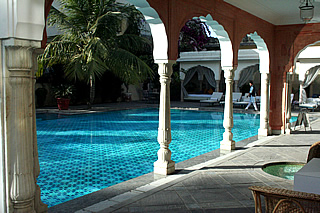
In Jaipur we stayed at the wonderful Samode Haveli, the 150 year-old manor house of the Samode Royal Family and converted to a heritage hotel in 1988. It has beautiful period decoration, a fine painted dining room and an elephant ramp to the entrance. The lovely courtyard is cool in the heat of the day with fountains, and pomegranate trees. We ate by candlelight in the courtyard every night of our stay here, with huge log fires (and strategically placed heaters) to ward off the chill. The food was excellent - we ate curries almost every evening during the holiday and had some really great meals.

The hotel also has a fabulous outdoor pool with a large bar and three enormous canopied "beds" with cushions and shady draperies. Surrounded by bougainvillea, palm trees and colourful plants it is a great place to relax in the later afternoon after a day's sight-seeing.
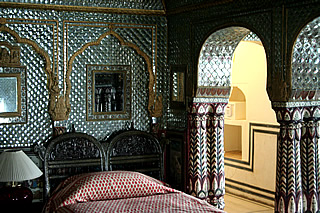


Our suite was fabulous with traditional architecture and a huge bathroom. We knew that there were two original rooms in the haveli and asked if we could see them. One was unoccupied and so we were able to take a look. The decoration is really amazing, with lots of mirrored walls and painted pillars.
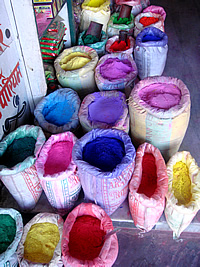



Jaipur is the capitol of Rajasthan, the home of the Rajputs - the "children of kings" and named after its founder, the great warrior Jai Singh II who ruled from 1688 to 1744, coming to power at the age of 11. The Rajputs, the warrior clans, successfully resisted the Mughals and were never ruled by them. When Mughal power began to decline the Rajputs allied themselves with the British. Following independence the 22 states of Rajputana eventually joined to form the new state of Rajasthan. Since 1856, when its buildings were given a coat of pink to welcome Prince Albert, Jaipur has been known as the Pink City, and the wash is regularly reapplied.
Monkeys roam freely in Jaipur, along with the ever-present cows. The streets are extremely noisy, mostly due to the traffic - horns are used with enthusiasm in India and the backs of all trucks are decorated with "Blow Horn" or something similar.
From our hotel we walked right through the centre of town to the fabulous covered bazaars - I particularly loved the amazing array of colourful sari materials, embroidered with mirrors or beads or decorated with traditional Rajasthani block-printed patterns.





We saw quite a few elephants on the roads. They all had their trunks painted and were probably returning from their morning work at the Amber Palace. It's a long walk for them - 11 kms there and back.
All through our walks around the city we saw many fine buildings with beautiful carved stone tracery but in a neglected state.
One evening in Jaipur we had dinner with a local family, arranged by TransIndus. The family lived in the Indra Market area - it was still very lively at 7pm. On the way we saw a procession of decorated horses and elephants, musicians and dancing girls - this was a wedding and looked great fun. They were holding up a good deal of traffic but that didn't seem to bother them!
Unfortunately this turned out to be rather a strained evening. The lady of the house was very nice and showed us all her different types of saris and her husband demonstrated how to make a turban from a 9.5m length of cloth - a kind of winding and twisting motion which completed the turban in about 20 seconds, creating a very sturdy structure of starched muslin.


Her husband also showed us the chart of his family tree. Heritage, and astrology, are very important in India, especially in marriage. His chart went back to the sixteenth century at which point it merged with the Maharaja's chart. Apparently a priest comes every year to note who is living in the house. Unfortunately the husband left before dinner to deliver a present at the wedding of a friend so we were only three at dinner. The head of the household was the grandfather, his seat in the living area was a very splendid special high sofa with cylindrical cushions.

On returning to our hotel we saw two more weddings and could hear fireworks from several directions - these lasted well into the night.
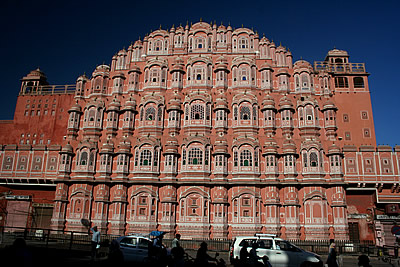
On Siredeori Bazaar heading south into the city is the Palace of the Winds. This most beautiful of pink sandstone buildings was created for the ladies of the palace. Unable to go out in public, it allowed them to see what was happening on the streets.


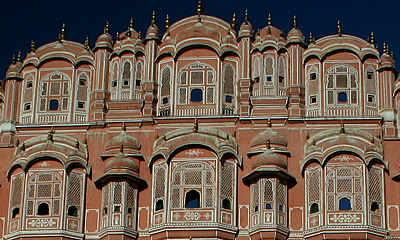
It is a narrow structure, with windows on both sides which have coloured glass in them. The larger apertures have shutters which can be opened, allowing the cooling breeze to blow through.





The palace architecture is a fusion of Mughal and Rajasthani. Though the surrounding wall was built by Jai Sing, the complex has been added to over the centuries. The Tripolia Gate is closed to the hoi poloi - entrance is via Virendra Pol, near the Jantar Mantar observatory.
The museum does not allow photography so no pictures here of the wonderful intricately embroidered textiles, all hand-made, including dresses, shawls, and the magnificently over-sized clothing of Madho SIngh I. These are housed in a delicate two-storeyed building, the Mubarak Mahal, made from white marble.
The beautiful Rajendra Pol, a gateway leading into the courtyard of the Diwan-i-Khas, is flanked by marble elephants complete with mahouts.
Filming was taking place in the palace (as in many places we visited) and the Diwan-i-Khas (the Hall of Private Audience), an elegant colonnaded building, was decked out with carpets and draperies which looked magnificent and gave some idea of how the palaces might have looked in the summer months in centuries past.




Inside the Diwan-i-Khas are a pair of immense silver urns, said to be the largest silver objects in the world.
The Pitam Niwas Chowk is a beautiful small courtyard with fabulously decorated gates - in particular the Peacock Gate is stunning. The gates represent the four seasons: Peacock for autumn, Rose for winter, Green for spring and Lotus for summer. From this courtyard can be seen the Chandra Mahal, the residence of the Royal Family (we saw the Maharaja here!).

Within the complex is a weapons museum full of fearsome daggers, swords and guns - the "welcome" sign is formed by daggers over the entrance! There is also the opportunity to see local craftsmen at work: miniature paintings, carved wooden objects, etc., and to buy if you wish.

We were both really looking forward to visiting this observatory and it lived up to the intriguing photographs we had seen of it. Maharaja Jai Singh built five astronomical observatories, this one in Jaipur between 1727 and 1733. Fourteen types of instrument made from stone and marble can measure the time, predict eclipses, and study astrology.

Astrological calculations are very important for determining auspicious days for weddings and other important events.



On the left as you enter is the Laghu Samrat Yantra, a red sandstone and white marble sundial, inclined at an angle of 27° - the same as the latitude of Jaipur. On either side are two quadrants - one for measuring local time in the morning, the other in the afternoon.
Nearby is the Nadivalaya Yantra: two sundials, one for summer, when the sun is in the northern hemisphere, and one for winter when the sun is in the southern hemisphere. It can give the time to within one minute accuracy.
In front of the Nadivalaya Yantra is the Jai Prakash Yantra: two hemispherical bowls with cutout curved marble slabs. A ring is suspended above the centre of each bowl allowing calculation of the day, time and positions of the zodiac.
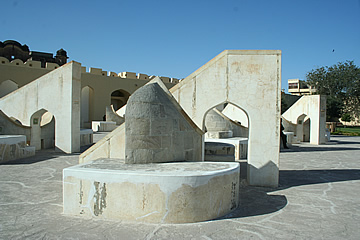

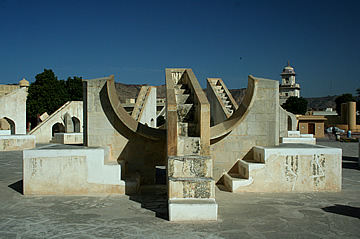


Twelve small instruments form the Rashi Yantra representing the twelve signs of the zodiac. The angle of inclination and orientation are particular to each sign.

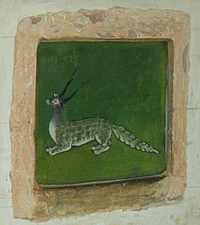

The most impressive instrument of all is the immense Brihat Samrat Yantra. Also inclined at an angle of 27° it can give the time to an accuracy of two seconds. It can also give other astronomical information such as the sun's declination.
More information on the various instruments can be found at: India site, UNESCO World Heritage

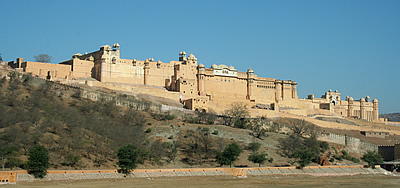
Amber, 11 km north of Jaipur, was a Rajput stronghold and capital of the Kuchwaha Rajputs from 1037 to 1728. The magnificent fort was built in 1600 and stands high above the town of Amber.


We ascended to the fort on an elephant. I had mixed feelings about this, with some concern about how the elephants were treated. This is not the right environment for these wonderful animals - the Indian elephants prefer a much wetter climate and lush vegetation. In particular their feet must suffer on the hot road surfaces, some of them live in Jaipur and do the return journey every day.

They didn't look too bad, but there is no water for them here which can't be good for them. They are restricted to five trips up to the palace complex every day, and do not carry tourists back down, working only in the morning. I did see one mahout whack his elephant quite hard on the head with a stick but didn't get his number so couldn't make a complaint - in any case I'd hesitate, perhaps he'd take it out on the elephant if he was penalised.


With these reservations we did ride the elephants to the palace. You mount from a platform at the level of the elephant's back and sit sideways on cushions. It is a very sedate ride with a good swaying motion.
After our visit we went to the animal aid office in the courtyard where the elephants start their walk up to the fort, to make a donation. The people who run the office try to look after all kinds of animals here, including the elephants.
2017 If we went back I would not do this again - many elephants used throughout Asia for tourism purposes are very cruelly treated. Since writing this article I've learned that elephants, including babies, undergo terrible beatings, confinements in cages, restraint with chains and worse to train them, though I don't know if this is the case here in Jaipur.
The palaces and fort are encompassed by an eighteen km wall known locally as the "little wall of China" and it does look remarkably like it with spurs coming down off the hillsides.

The palace complex has four main areas, each with its own courtyard. The first courtyard, Jaleb Chowk, is a vast space entered via the the Suraj Pol, the sun gate, which faces east. Before going through the Singh Pol - the Lion Gate - into the second courtyard we were taken by our guide into the small Hindu Temple dedicated to Kali in her goddess of war aspect, Sila. No cameras are allowed inside the temple where we were blessed and had our foreheads smeared with red paste.
Through into the second courtyard is the Diwan-i-Am - the Hall of Public Audience with wonderful pillars topped by elephant capitals.


The Maharaja's apartments are reached through the exquisitely painted Ganesh Pol which leads into a lovely courtyard with Islamic style gardens with fountains and geometric flower beds. These were being renovated at the time of our visit along with quite a lot of the buildings.


Women were employed to do much of the labouring - carrying water in flat bowls on their heads, sometimes right to the top of the palace, then returning with the bowls filled with rubble.


The highlight of the fort is in this courtyard: the magnificent Sheesh Mahal or Mirror Palace. The columns of the arcade surrounding the hall are equally beautiful, being carved with high relief insects. Our guide revealed various creatures in one carving simply by covering various bits of it with his hands.


The walls of the Sheesh Mahal are studded with patterns in fragments of mirror and coloured glass. The lower walls are carved marble reliefs of flowers in vases.
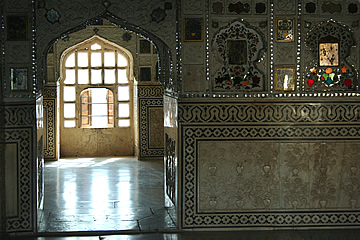





The most amazing room we saw in all of the forts and palaces that we visited in India.


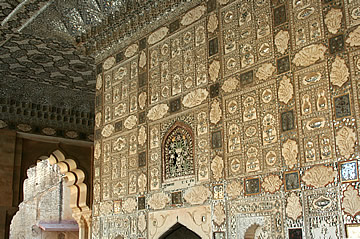


Below the Amber Fort gardens were being renovated. These are beautiful geometric beds with symmetric water courses running through them.


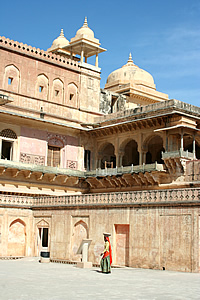



As we returned to Jaipur from the Amber Palace we stopped to look at the beautiful eighteenth century Jal Mahal or Water Palace. It still looks lovely though it is in bad shape sitting in the middle of a polluted lake.